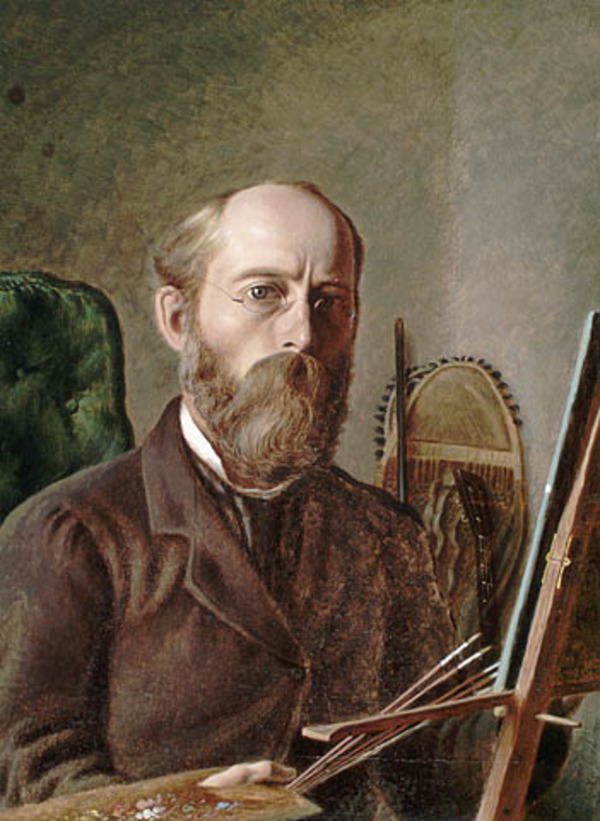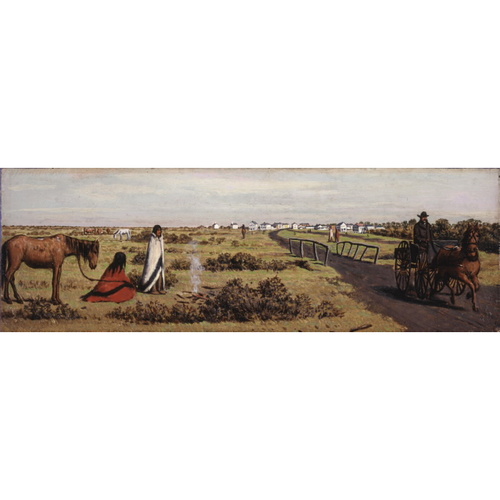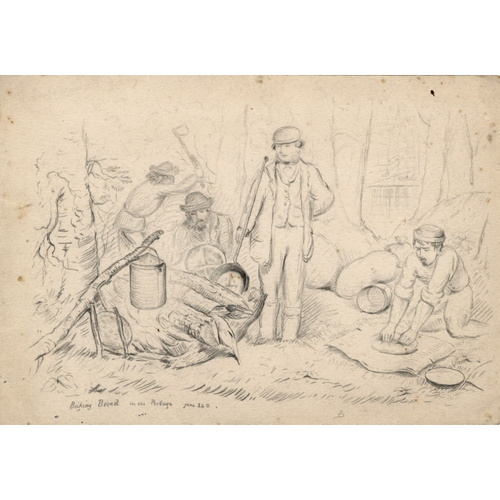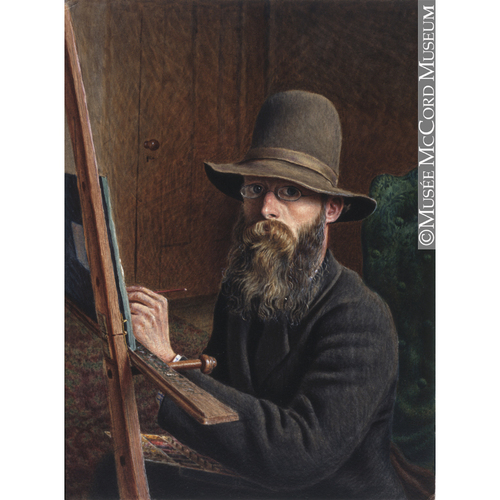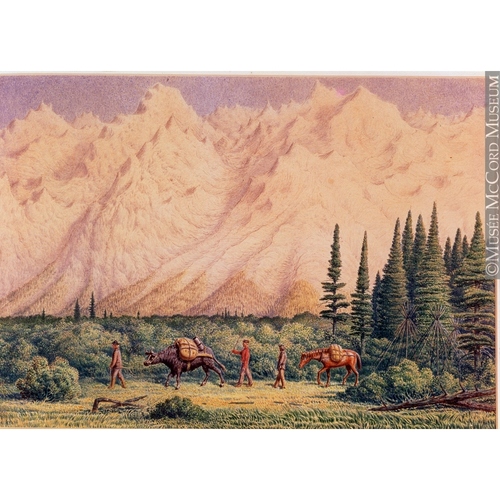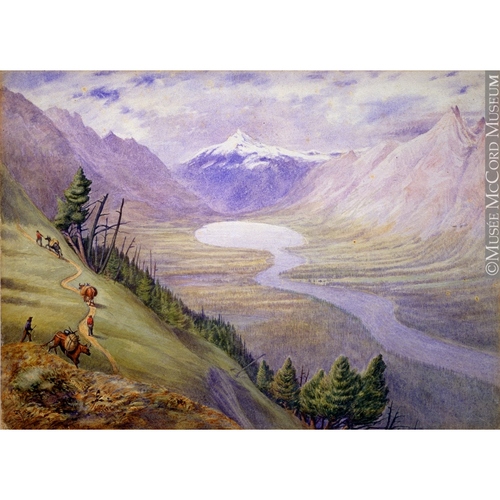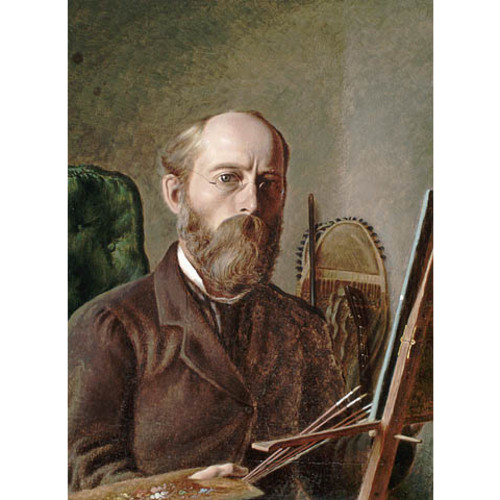HIND, WILLIAM GEORGE RICHARDSON, painter; b. 12 June 1833 at Nottingham, England, son of Thomas Hind and Sarah Youle; d. unmarried 18 Nov. 1889 at Sussex, N.B.
William George Richardson Hind, the son of a lace manufacturer, immigrated to Canada in 1851 and joined an elder brother, Henry Youle Hind*, who had settled in Toronto earlier and was establishing a reputation as an intellectual. Henry played a major role as constant mentor to William who apparently lacked his brother’s stability of temperament. Details of William Hind’s art training are unknown since statements reporting study in Nottingham, London, and on the Continent cannot be confirmed. However, his education was such that on his arrival in Toronto at the age of 18 he was appointed “Drawing Master” at the Toronto Normal School (probably at Henry’s instigation) where he served from November 1851 to November 1857. During this time he maintained a studio in Toronto and exhibited paintings at the Upper Canada Provincial Exhibition of 1852. No paintings executed in Toronto have been located but the titles of two, Reading the news and Waiting for the bat, indicate that they were in the popular narrative genre style, consistent with a strain developing in England and the United States and paralleled in Montreal by Cornelius Krieghoff* and James D. Duncan. Hind revisited England at the end of the decade, presumably to familiarize himself with the latest developments in British art.
The artist returned to Canada in May 1861. After this time Hind’s movements, traceable through the subject matter of his paintings, can be confirmed in the few ephemeral references which are available. When William disembarked at Quebec in 1861 he discovered his brother already in that city en route to explore the little known Moisie River which flows into the lower St Lawrence. William joined the party as expedition artist. He sketched landscapes in this region, made detailed botanical and ethnological studies, and recorded the customs of the local Naskapi and Montagnais Indians. Over 100 of these sketches survive; some were used, without retouching, as woodcut illustrations in Henry’s published report, Explorations in the interior of the Labrador peninsula (1863). After the party’s return to Toronto, William used other field studies as a basis for painting an important series of large finished water-colours; 16 of these were made into coloured lithographs for inclusion in the same report. One of them, The game of bones, epitomizes his artistic approach. The painting is highly romantic in subject matter: two Indians, intensely absorbed, gamble away their belongings in a rocky northern setting. But Hind treats the subject with the cold detachment and objectivity found in certain Pre-Raphaelite paintings. A few of the expedition studies illustrate mythological Naskapi tales; evidently the artist drew on his imagination in painting these and they lack the realistic conviction evident in other studies which portray actual incidents. The unemotional realism found in The game of bones also characterizes his six known self-portraits, and is particularly evident in the finest of these in which the artist with his palette sits before his studio easel.
During the winter of 1861–62 rumours of sensational gold discoveries in British Columbia swept Toronto. Hind joined an “Overlanders” group [see Thomas McMicking*] and set out for the Cariboo in April 1862. The party purchased Red River carts at Upper Fort Garry (Winnipeg) and followed the old fur traders’ trails across the prairies. During the trip Hind made himself so objectionable that his comrades ostracized him and he was forced to travel alone for several days before he was forgiven. Between Fort Garry and Jasper House (Alta) Hind kept a sketch-book which records the party winding across the open prairie, fording swollen streams, hunting duck and buffalo, and passing the hours in camp. A parallel series of finished water-colours details other incidents on the prairies as well as some farther west: threading through formidable forests and muskeg in the foothills, scaling steep mountains, and arriving in Victoria after a cursory look at the Cariboo gold fields. Realism and skilful use of the water-colour medium characterize the group.
Hind lived in Victoria for the next seven years. There are few references to his life there but on 25 Feb. 1863 the Daily British Colonist noted his talent as a sign painter; it was an era when trade and tavern signs overhanging wooden sidewalks were a characteristic of the local scene. Two years later the Colonist praised him lavishly for his views of British Columbia destined for display in England to encourage emigration. As well he occasionally painted scenes of the activities of the local Indians. Historically his most significant oil and water-colour paintings of these years picture mining life in the Cariboo and probably date from a visit in 1864.
Hind appears to have left Victoria for the east in 1869. He arrived at Winnipeg in the fall and did not leave until at least the following autumn when the settlement was being designated as the capital of the new province of Manitoba. Several oil paintings which depict homestead life in the area vary tremendously in quality. The finest, picturing an ox pulling a Red River cart along a country road, is executed in a highly realistic, almost trompe-l’œil, manner. In contrast, other Fort Garry oils, particularly studies of Indians, are weak in composition, lack texture, and are undistinguished in subject matter. In June 1870 two woodcuts of Cree and Ojibwa Indians appeared in the Illustrated London News as the first of a series to illustrate life in “the new province,” but no further work by Hind was published.
Henry Youle Hind had moved to Windsor, N.S., in 1866 and William followed him to the Atlantic region late in 1870 where he seems to have abandoned professional artistic ambitions. He spent his later years in Nova Scotia and New Brunswick and probably worked as a draughtsman for the International Railway Company. But as an avocation he continued to sketch vignettes in pencil, water-colour, and oil, picturing life in smaller centres such as Shediac, N.B., Matapédia, Que., as well as Pictou and Windsor, N.S. The most delightful, which include Pictou streets, port activities, the repairing of undersea cables, and the building of wooden ships, appear in an 1876 diary converted into a sketch-book. These gentle paintings contrast with the subdued but nevertheless evident excitement and spirit of adventure in his earlier western works. A belated honour for Hind was the inclusion of one of his paintings in the Colonial and Indian Exhibition in London in 1886. His last six years were spent in Sussex, N.B., where, at the time of his death, a local newspaper commented on his artistic ability, fondness for sports, well-informed mind, and “grand and occasionally eccentric habits.”
Realism in Hind’s paintings is of a quality rarely found in Canadian art but characteristically Victorian in mood. Detail is added to detail to create an aesthetic attuned to the Victorian search for analytical knowledge and concern with materialism. By outlining every stone on the beach, every leaf on the tree, and by rendering birds and flowers with an exactitude which makes the species readily identifiable, he sees with the eyes of Darwin or of Audubon. Even such subjects as Cariboo tavern scenes are treated with the detachment of Dutch or Flemish genre which makes their subject matter acceptable in a moralizing age.
The most complete list of institutions holding work by Hind is in Harper, Early painters and engravers. Other works are held in the National Gallery of Canada (Ottawa) and in Dalhousie University (Halifax).
PABC, Stephen Redgrave, Journals, and sundry papers, 1872–75 (typescript). PANS, ms file, W. G. R. Hind, letters, 1870. H. Y. Hind, Explorations in the interior of the Labrador peninsula, the country of the Montagnais and Nasquapee Indians (2v., London, 1863). Daily British Colonist (Victoria), 25 Feb. 1863, 19 April 1865. Catalogue of a collection of drawings and watercolours by the Canadian artist William George Richardson Hind . . . which will be sold by auction by Messrs. Sotheby & Co. . . . ([London, 1967]). J. R. Harper, Everyman’s Canada; paintings and drawings from the McCord Museum of McGill University (Ottawa, 1962). William G. R. Hind (1833–1888); a confederation painter in Canada: an exhibition organized and circulated by Willistead Art Gallery of Windsor for centennial year, 1967 ([Windsor, Ont., 1967]). J. R. Harper, Painting in Canada; William G. R. Hind (Ottawa, 1976). M. S. Wade, The Overlanders of ’62, ed. John Hosie (Victoria, 1931). G. F. G. Stanley and L. C. C. Stanley, “The brothers Hind,” N.S. Hist. Soc., Coll., 40 (1980): 109–32.
Cite This Article
J. Russell Harper, “HIND, WILLIAM GEORGE RICHARDSON,” in Dictionary of Canadian Biography, vol. 11, University of Toronto/Université Laval, 2003–, accessed April 4, 2025, https://www.biographi.ca/en/bio/hind_william_george_richardson_11E.html.
The citation above shows the format for footnotes and endnotes according to the Chicago manual of style (16th edition). Information to be used in other citation formats:
| Permalink: | https://www.biographi.ca/en/bio/hind_william_george_richardson_11E.html |
| Author of Article: | J. Russell Harper |
| Title of Article: | HIND, WILLIAM GEORGE RICHARDSON |
| Publication Name: | Dictionary of Canadian Biography, vol. 11 |
| Publisher: | University of Toronto/Université Laval |
| Year of revision: | 1982 |
| Access Date: | April 4, 2025 |


